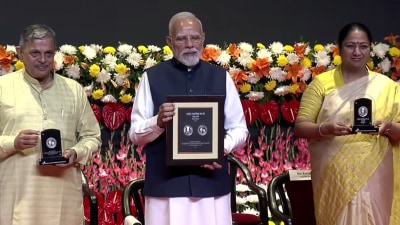Stay updated with the latest - Click here to follow us on Instagram
As rainwater flows down the drain,plans on to tap Yamuna surplus
While many low-lying areas were submerged after the heavy showers on Monday,experts say the city would soon return to fighting with dry taps in all likelihood.
While many low-lying areas were submerged after the heavy showers on Monday,experts say the city would soon return to fighting with dry taps in all likelihood.
Reason: there is no provision to collect the rainwater in Yamuna,once Delhis lifeline.
While the river gets around 580 million cubic metres (MCM) water each monsoon,authorities are yet to develop any method to store this surplus. Of this 580 MCM,experts say as much as 280 MCM gets wasted every year.
Such is the sorry state that Environment and Forests Minister Jairam Ramesh,speaking on ecosystems,water and climate change,said,The Yamuna is not a river.
Its only in the monsoon,in fact,that the Yamuna comes close to being a river.
To address the issue,the Prime Ministers Office held a brainstorming session this month on how to utilise the Yamuna floodwater. Lieutenant-Governor (L-G) Tejendra Khanna,chairman of the Prime Minister-appointed Yamuna River Development Authority,is expected to submit a comprehensive report to the PM soon.
But with everything still at the drawing board stage,precious water is going down the drain,literally as seen on Monday. A plan to raise the height of Okhla barrage to store Yamunas water never took off. A 2002 INTACH study,commissioned by the Delhi Jal Board which proposed diverting floodwater to Jahangirpuris marshlands,was discarded.
Strategies to utilise monsoon surplus are on the agenda now.
The plan to raise the level of Okhla barrage could not be implemented as the barrage is in no position to support another meter of construction. But the Lieutenant Governors report will focus on ways of storing floodwater, Ranjan Mukherjee,Officer on Special Duty to the L-G,said.
Experts say the Yamuna flood is essential as it flushes out pollutants in the river,but better ways of utilising the water are required. One way to do this at present is through dewatering and refilling of aquifers on the floodplain,say experts. Before the monsoons,the water table here is dewatered that is,meaning water is pumped out for two to three metres so that the water table can recharge itself and prevent flooding during the monsoon.
The Central Ground Water Board has 90 wells on the Palla-Burari stretch of the river. And there are plans to do this at more points along stretches identified as Okhla-Jaitpur and Akshardham-Sarai Kale Khan,though this has never been done yet.
The danger of not paying attention to rainwater flooding,however,was seen on Monday. While the Barapullah drain in Defence Colony is being covered in some areas to create parking space for the Commonwealth Games,
the drain overflowed in Defence Colony following just four hours of sharp showers on Monday evening,thereby filling up houses and streets with sludge.







